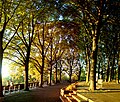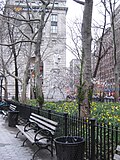Top Qs
Timeline
Chat
Perspective
New York City scenic landmarks
From Wikipedia, the free encyclopedia
Remove ads
The New York City Landmarks Preservation Commission (LPC), which administers the city's Landmarks Preservation Law, has designated twelve scenic landmarks across three New York City boroughs as of 2024[update]. The scenic landmarks include public parks, plazas, and parkways operated by the New York City government. The LPC's rules dictate that scenic-landmark status may be granted to sites with "special character or special historical or aesthetic interest or value" to New York City, New York state, or the U.S.[1] Seven of the twelve scenic landmarks were designated in the 1970s. The borough of Manhattan has the most scenic landmarks (with seven), while Brooklyn has four scenic landmarks and the Bronx has one. The first landmark to be designated was Central Park in Manhattan, while the most recent (as of 2024[update]) is Aqueduct Walk in the Bronx.

Remove ads
Background
Summarize
Perspective
The New York City Landmarks Preservation Commission (LPC) is the New York City governmental commission that administers the city's Landmarks Preservation Law.[2] The commission administers four types of landmarks: individual landmarks, interior landmarks, scenic landmarks, and historic districts.[1][3] Scenic landmarks are city-owned sites with "a special character or special historical or aesthetic interest or value" to New York City, New York state, or the U.S.,[1] which are also at least 30 years old.[4] As of May 2024[update], the LPC has designated 12 scenic landmarks.[5] Some landmarks are also on the National Register of Historic Places (NRHP), a separate program administered by the National Park Service.[6]
New York City mayor Robert F. Wagner Jr. authorized the LPC to formally designate historic structures as landmarks in April 1965,[7] and the LPC designated its first-ever official landmarks in October 1965.[8] Initially, only historic districts and the exteriors of buildings could be designated as landmarks. In 1973, mayor John Lindsay signed legislation that allowed the LPC to designate sites as scenic and interior landmarks.[9][10][11]
The first scenic-landmark designation to be proposed was that of Central Park in the borough of Manhattan,[12] which was formally designated on April 16, 1974.[13] The LPC approved two additional scenic landmarks in Manhattan that year—Grand Army Plaza on July 23[14] and Bryant Park on November 12.[15] Two more scenic landmarks were added on January 28, 1975: Verdi Square on Manhattan's Upper West Side,[16][17] along with Ocean Parkway, the first scenic landmark in Brooklyn.[16][18] These were followed by two additional landmarks in Brooklyn: Prospect Park became a scenic landmark on November 25, 1975,[19] followed by Eastern Parkway on August 22, 1978.[20] Riverside Park and the adjacent Riverside Drive on Manhattan's Upper West Side were designated as a single scenic landmark on February 19, 1980.[21][22] After Fort Tryon Park in Washington Heights, Manhattan, was granted landmark status on September 20, 1983,[23] no more scenic landmarks were designated for another 25 years.[24][4]
As of 2024[update], three scenic landmarks have been designated in the 21st century.[25][26] Morningside Park, straddling the Morningside Heights and Harlem neighborhoods of Manhattan, was designated a New York City landmark on July 15, 2008.[27][28] The LPC also named the Riegelmann Boardwalk in Coney Island, Brooklyn, as a landmark on May 15, 2018,[29][30] after previously refusing to give landmark protection to the boardwalk.[31] On April 16, 2024, Aqueduct Walk was designated as the first official scenic landmark in the borough of the Bronx.[32] The designation of Aqueduct Walk coincided with the 50th anniversary of the LPC's first scenic landmark designation.[33][34]
Remove ads
Scenic landmarks
Remove ads
Notes
- For an interactive map, refer to "Discover New York City Landmarks". New York City Landmarks Preservation Commission – via ArcGIS.
References
Sources
Wikiwand - on
Seamless Wikipedia browsing. On steroids.
Remove ads












